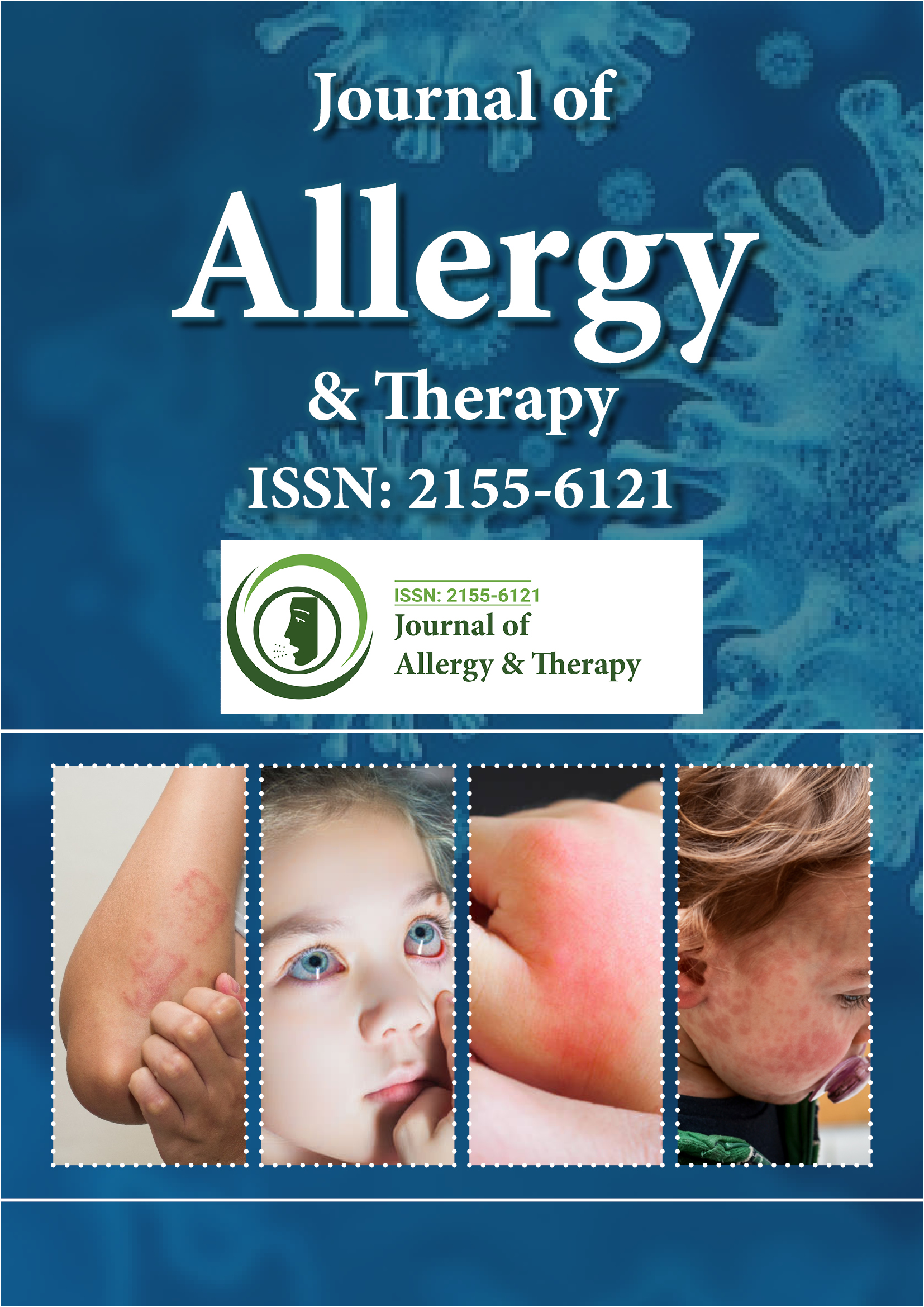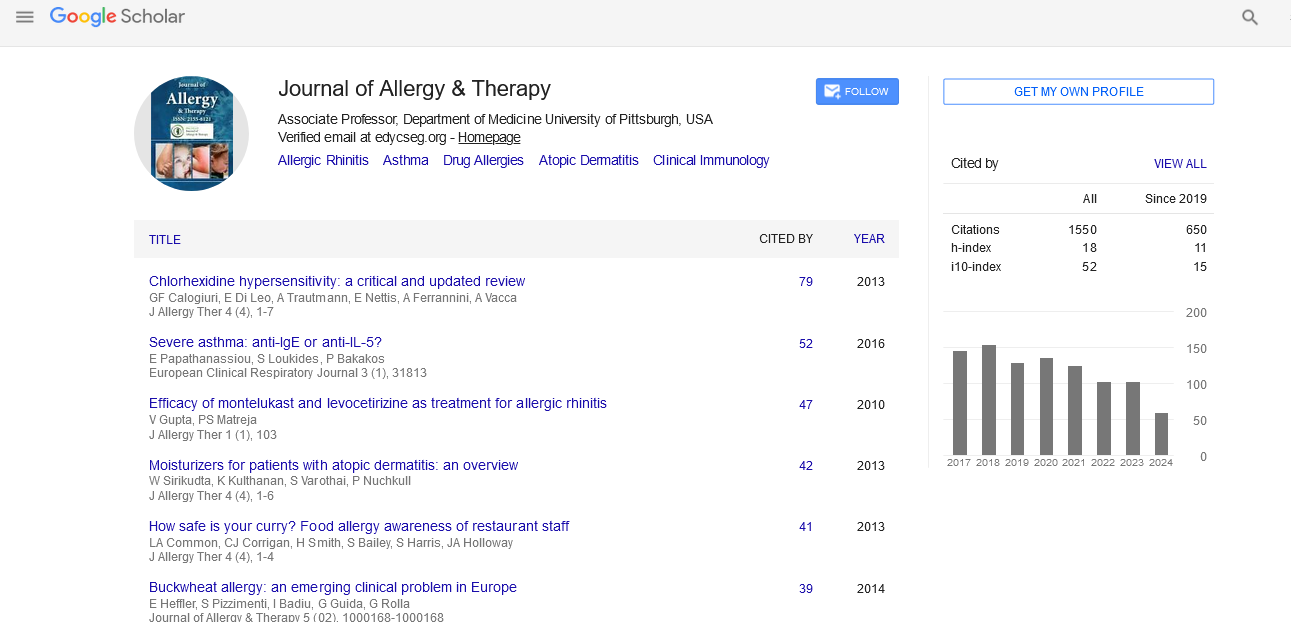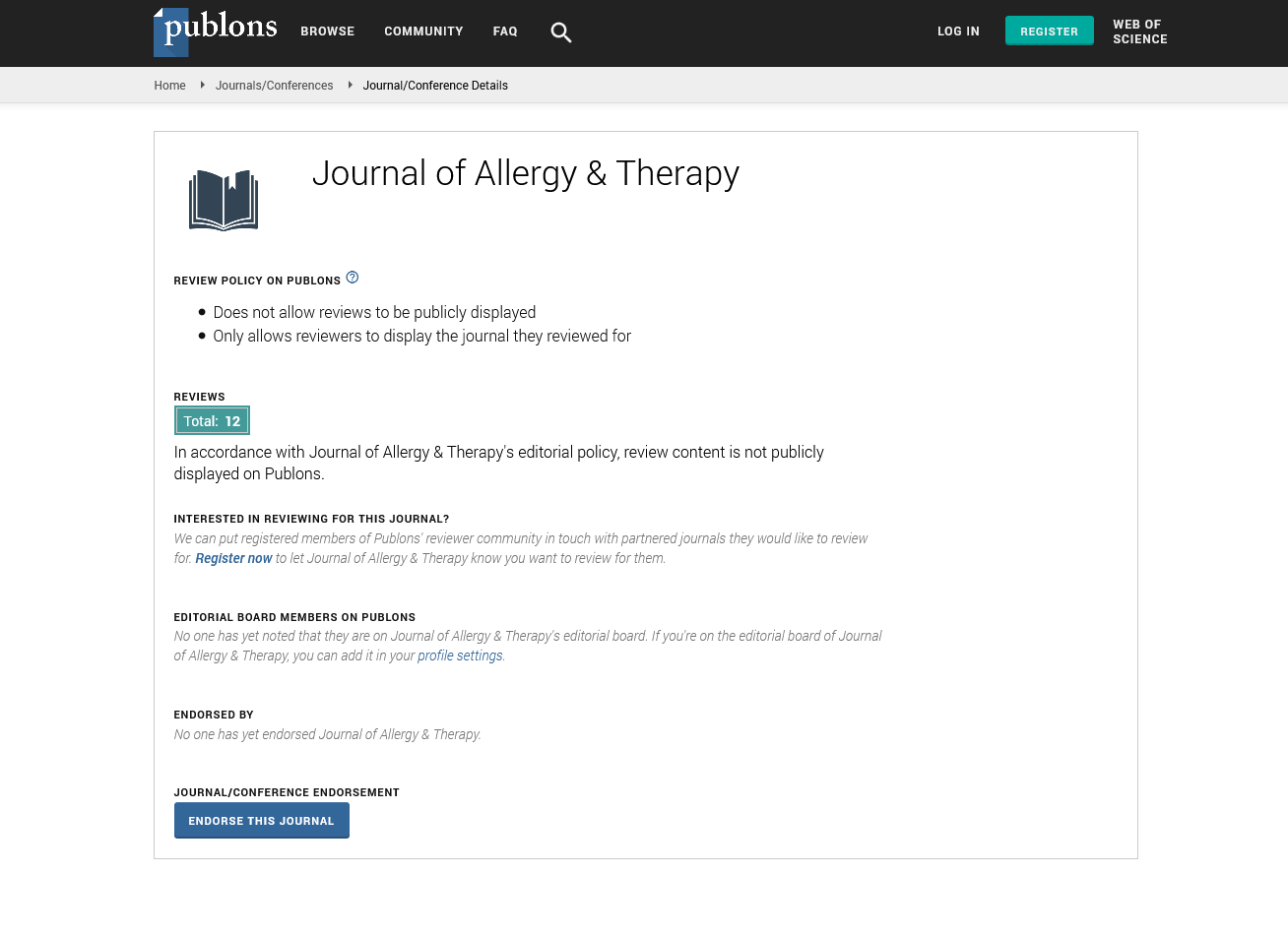Indexed In
- Academic Journals Database
- Open J Gate
- Genamics JournalSeek
- Academic Keys
- JournalTOCs
- China National Knowledge Infrastructure (CNKI)
- Ulrich's Periodicals Directory
- Electronic Journals Library
- RefSeek
- Hamdard University
- EBSCO A-Z
- OCLC- WorldCat
- SWB online catalog
- Virtual Library of Biology (vifabio)
- Publons
- Geneva Foundation for Medical Education and Research
- Euro Pub
- Google Scholar
Useful Links
Share This Page
Journal Flyer

Open Access Journals
- Agri and Aquaculture
- Biochemistry
- Bioinformatics & Systems Biology
- Business & Management
- Chemistry
- Clinical Sciences
- Engineering
- Food & Nutrition
- General Science
- Genetics & Molecular Biology
- Immunology & Microbiology
- Medical Sciences
- Neuroscience & Psychology
- Nursing & Health Care
- Pharmaceutical Sciences
Short Communication - (2022) Volume 13, Issue 12
Cow's Milk Oral Immunotherapy and the Development of Milk Allergy Naturally in Children
Benoit Sharabi*Received: 28-Nov-2022, Manuscript No. JAT-22-19232 ; Editor assigned: 02-Dec-2022, Pre QC No. JAT-22-19232 (PQ); Reviewed: 16-Dec-2022, QC No. JAT-22-19232 ; Revised: 23-Dec-2022, Manuscript No. JAT-22-19232 (R); Published: 30-Dec-2022, DOI: 10.35248/2155-6121.22.13.322
Description
Approximately 10% of the world's population suffers from a food allergy, which has become more common over the past few decades. A prevalent condition in infants and young children, Cow's Milk Allergy (CMA) has a high rate of spontaneous resolution from early childhood through puberty. CMA has long-term effects on growth and nutrition and can occasionally cause allergic reactions. A common advice from doctors to patients is to refrain from consuming any products made from cow's milk on a daily basis. Oral allergen-specific Immunotherapy (OIT) is a successful and curative therapy that induces clinical and immunologic tolerance to milk allergens in allergic patients as an alternative to removing cow's milk from the patient's diet. For the development of new treatments for food allergies as well as for furthering the effectiveness of current ones, it is essential to comprehend immune tolerance mechanisms to food allergens [1,2].
Immunoglobulin E (IgE)-mediated and non-IgE-mediated allergic reactions to cow's milk and other food allergens can be categorised using these two main pathways. B cells control the onset of IgE-mediated CMA by producing IgE antibodies that are unique to the allergen. It is still unclear how B cells react in allergic reactions and grow into tolerant cells. Therefore, studying B cell responses in food-allergic patients undergoing OIT and in those who lose their food allergy due to the development of a natural immunological tolerance may help to understand how to induce and maintain food allergen tolerance [3].
A useful model to investigate immunological tolerance to dietary allergens is the natural development of food allergies. There haven't been many well-designed research done yet on how people naturally become tolerant to food allergies. Wide variations in reported rates of resolution (natural outgrowth) are most likely caused by methodological variations in research populations. Some food allergies, like cow's milk and eggs, are challenging to avoid but thankfully have a relatively high possibility of natural expansion. Children's diets can be safely loosened to include milk and eggs, which offers significant nutritional and quality-of-life benefits. It was shown that, compared to kids who still had a clinically active allergy, tolerant kids who outgrew their allergy had higher frequencies of circulating CD4+CD25+ Treg cells and lower in vitro proliferative responses to bovine beta-lactoglobulin. A successful OIT strategy is needed since other food allergy sources, in particular peanuts and tree nuts, have substantially lower spontaneous resolution rates [4].
A study on the function of allergen-specific B cells in natural tolerance has not been made, nor have the molecular processes of the spontaneous development of food allergies been thoroughly investigated. The generation of IgE antibodies specific to food allergens is significantly influenced by local Class-Switch Recombination (CSR) to IgE in the gut, according to research on B cell responses in peanut allergy. The majority of circulating IgE+ B cells has an immature plasmablast character. Increased circulating levels of IgE+ plasmablasts and memory B lymphocytes are associated with the prevalence of food allergies and may play a role in pathogenesis [5].
Conclusion
In people with NT and OIT-induced tolerance to cow's milk, we showed a thorough analysis of the transcriptome, secreted proteins, and specific antibodies of allergen-specific B cells. We show that both the induction of tolerance and desensitisation exhibit different modifications in allergen-specific B lymphocytes. One step further in the silencing of B cell activation genes following desensitisation are the transcriptome alterations in particular B cells in OIT-induced tolerance. When compared to desensitised people, OIT-induced tolerance shows more extensive and varied gene expression suppression mechanisms. Due to type 2 cytokine-related genes, allergen-specific B lymphocytes are seen in an inflammatory environment in allergic patients. Specific B cells that have a suppressor capacity following OIT change this proinflammatory environment.
Children who outgrow food allergies and those who develop OIT-induced tolerance have some parallels and some variances. With the expression of additional innate immune receptors in NT, B cells appear to have undergone one step more differentiation to the pre-plasma stage. Breg cellrelated genes are still active during OIT-induced tolerance, with IGHG4, IL10, and TGF- gene expression being increased. Overall, our research showed that OIT and natural tolerance both activate allergen-specific B cells, and that these cells undergo significant gene expression changes that may play a significant role in the development and maintenance of immunological tolerance.
References
- Yilmaz O, Reisli I, Tahan FU, Orhan FA, Boz AB, Yuksel H. Influence of education on primary care physicians’ knowledge on childhood allergy as a systemic disease and the atopic march. Allergol Immunopathol 2011; 39(2):73-78.
[Crossref] [Google Scholar] [Pubmed]
- Bjerg A, Ekerljung L, Middelveld R, Dahlén SE, Forsberg B, Franklin K, et al. Increased prevalence of symptoms of rhinitis but not of asthma between 1990 and 2008 in Swedish adults: Comparisons of the ECRHS and GA2LEN surveys. PloS one. 2011; 6(2):e16082.
- Salo PM, Arbes Jr SJ, Crockett PW, Thorne PS, Cohn RD, Zeldin DC. Exposure to multiple indoor allergens in US homes and its relationship to asthma. J Allergy Clin Immunol. 2008; 121(3):678-684.
[Crossref] [Google Scholar] [Pubmed]
- Abdulrahman H, Hadi U, Tarraf H, Gharagozlou M, Kamel M, et al. Nasal allergies in the Middle Eastern population: results from the “Allergies in Middle East Survey”. Am J Rhinol Allergy. 2012;26(6):S3-23.
[Crossref] [Google Scholar] [Pubmed]
- Keith PK, Desrosiers M, Laister T, Schellenberg RR, Waserman S. The burden of allergic rhinitis (AR) in Canada: perspectives of physicians and patients. Allergy Asthma Clin Immunol. 2012; 8(1):1-1.
[Crossref] [Google Scholar] [Pubmed]
Citation: Sharabi B (2022) Cow's Milk Oral Immunotherapy and the Development of Milk Allergy Naturally in Children. J Allergy Ther. 13:322.
Copyright: © 2022 Sharabi B. This is an open access article distributed under the terms of the Creative Commons Attribution License, which permits unrestricted use, distribution, and reproduction in any medium, provided the original author and source are credited.


